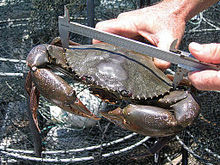Scylla is a genus of swimming crabs, comprising four species,[1] of which S. serrata is the most widespread. They are found across the Indo-West Pacific.[2] The four species are:[3][1]
| Scylla | |
|---|---|

| |
| Scylla serrata | |
| Scientific classification | |
| Domain: | Eukaryota |
| Kingdom: | Animalia |
| Phylum: | Arthropoda |
| Class: | Malacostraca |
| Order: | Decapoda |
| Suborder: | Pleocyemata |
| Infraorder: | Brachyura |
| Family: | Portunidae |
| Subfamily: | Portuninae |
| Genus: | Scylla De Haan, 1833 |
| Image | Scientific name | Common name | Distribution |
|---|---|---|---|
 |
Scylla olivacea (Herbst, 1796) | orange mud crab | Southeast Asia to Pakistan, and from Japan to northern Australia |
 |
Scylla paramamosain Estampador, 1949 | South China Sea south to the Java Sea | |
 |
Scylla serrata (Forskål, 1775) | black crab | Southern Japan to south-eastern Australia, northern New Zealand |
| Scylla tranquebarica (Fabricius, 1798) | Pakistan and Taiwan to the Malay Archipelago and other Indo-Pacific regions |
References
edit- ^ a b Peter K. L. Ng; Danièle Guinot & Peter J. F. Davie (2008). "Systema Brachyurorum: Part I. An annotated checklist of extant Brachyuran crabs of the world" (PDF). Raffles Bulletin of Zoology. 17: 1–286.
- ^ L. Le Vay (2001). "Ecology and management of mud crab Scylla spp". Asian Fisheries Science. 14: 101–111. Archived from the original on 2011-07-25.
- ^ Keenan, Clive P.; Davie, Peter J.F.; Mann, David L. (1998). "A revision of the genus Scylla de Haan, 1833 (Crustacea: Decapoda: Brachyura: Portunidae)". The Raffles Bulletin of Zoology. 46 (1): 217–245.